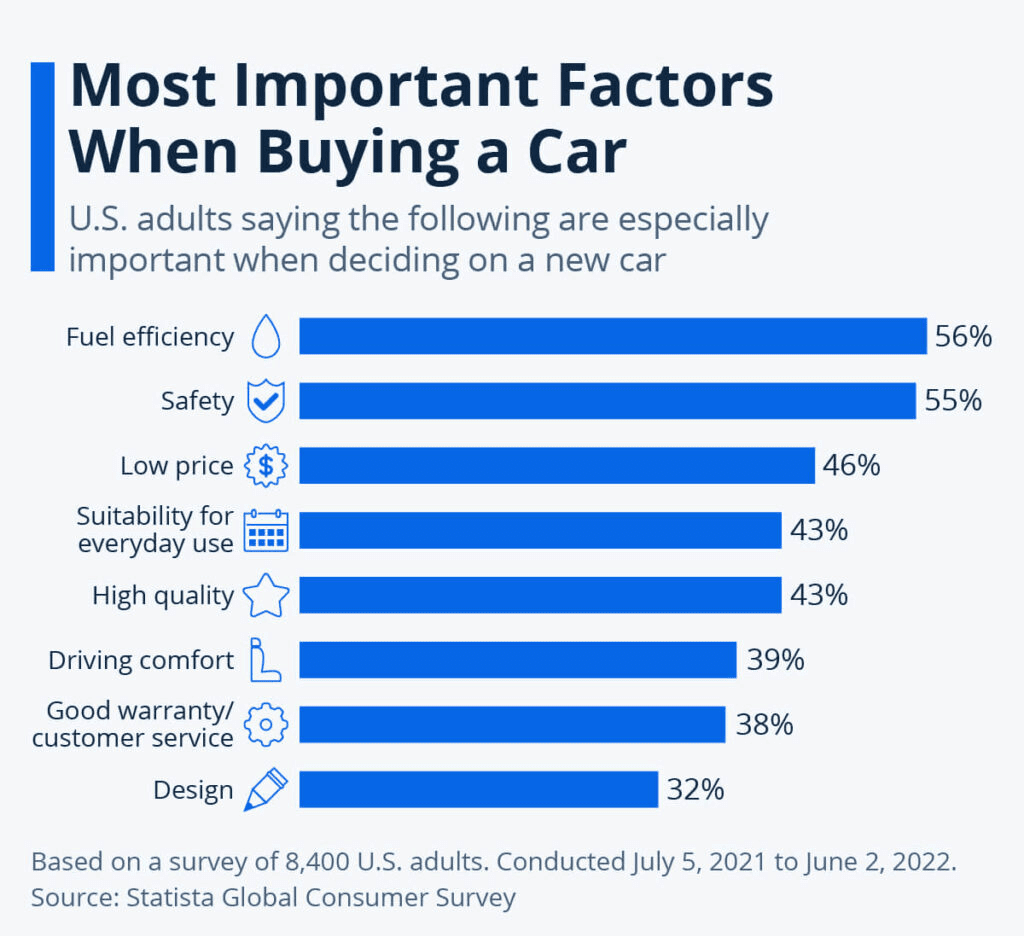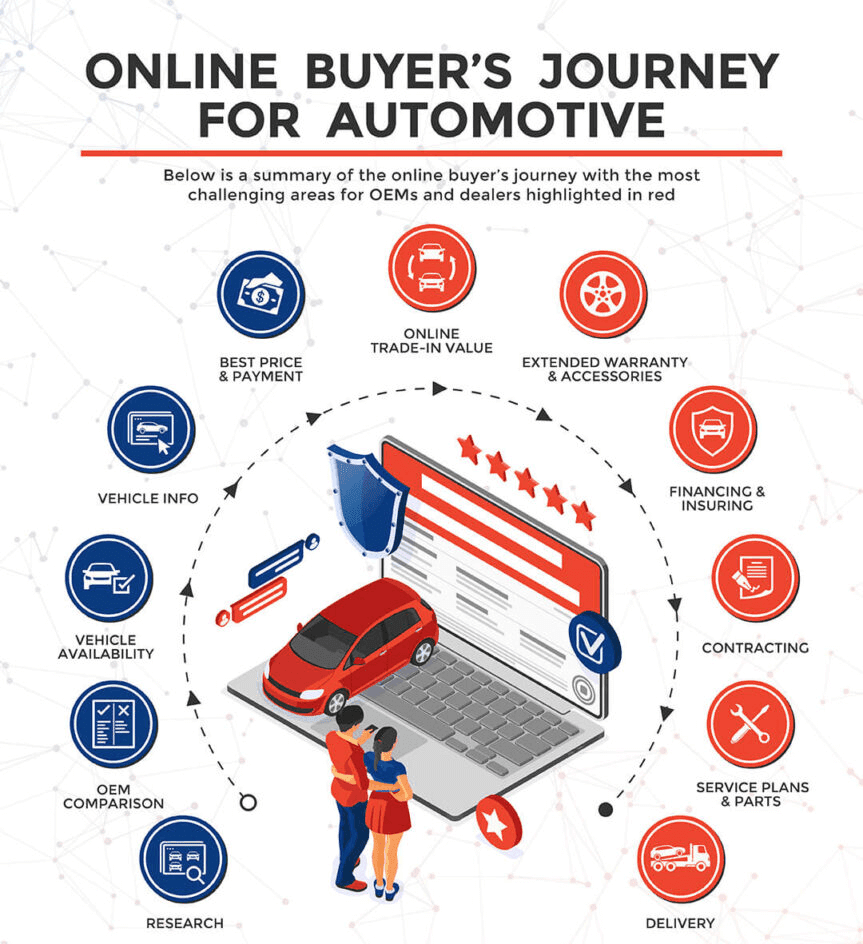Are you tired of seeing your car dealership’s lot full of unsold inventory? Do you feel your marketing efforts are in vain while your competitors outpace you in sales? No need to worry because we have the solution for you! Put your seatbelt on and shift your dealership into overdrive as we introduce you to targeted marketing strategies that will help you increase your car sales and give you an edge over your competition.
Get ready to find out how to reach the right audience, create tailored promotional messages, and ultimately supercharge your revenue. This post will explore innovative tactics and highlight best practices that will transform your car dealership into a selling machine. Stay tuned and keep reading – we promise you’ll be driving down the road to success in no time!
Importance of Online Advertising in Automotive Marketing
The importance of online advertising in automotive marketing cannot be overstated, especially in today’s digital age. With a majority of consumers starting their car buying journey online, it is crucial for dealerships to have a strong online presence to attract these potential buyers. In fact, a significant percentage of car sales today are initiated through online channels before the customer visits the dealership for the final purchase.
Online advertising in automotive marketing helps dealerships increase brand awareness, reach a wider audience, and boost their overall sales. It provides an array of tools and platforms that enable dealerships to deliver targeted, personalized, and timely messages to potential buyers. By leveraging digital advertising strategies such as search engine optimization (SEO), pay-per-click (PPC) advertising, social media marketing, and content marketing, dealerships can effectively engage with prospects and convert them into loyal customers.
Moreover, online advertising allows automotive marketers to measure the performance of their campaigns accurately and track their return on investment (ROI). This data-driven approach enables dealerships to make informed decisions, optimize their marketing efforts, and allocate resources more efficiently, ultimately driving more sales.
In conclusion, online advertising is essential to automotive marketing, allowing dealerships to connect with, engage, and convert prospective buyers more effectively. By leveraging the power of digital advertising, dealerships can ultimately increase their car sales, enhance customer relationships, and stay ahead of the competition in the ever-evolving automotive landscape. [1][2]

Building Trust with Customer Reviews
Building trust with potential customers is essential for driving sales in today’s competitive automotive market. One of the most effective ways to achieve this is by showcasing customer reviews on various platforms such as Yelp, Google, social networks, and the dealership’s website. Positive reviews can significantly influence a potential buyer’s decision to choose one dealership over another, making it crucial for automotive marketers to receive good reviews and ensure that they are easily accessible to anyone conducting research.
To further enhance trust and customer relationships, dealerships can consider creating testimonial videos featuring satisfied customers. These videos can be shared on the dealership’s website and social media platforms and even used in paid advertising campaigns, allowing potential buyers to see the positive experiences of others who have had dealings with the dealership. This can help alleviate any concerns or doubts, ultimately increasing the likelihood of them choosing your dealership for their vehicle needs. Additionally, encourage satisfied customers to share their positive experiences with friends and family, as personal recommendations can greatly influence a potential buyer’s decision-making process. [3][4]
Being at the Top of the Google SERP
In the competitive world of car sales, being at the top of Google’s search engine results page (SERP) can significantly impact your dealership’s success and profitability. As the majority of consumers turn to the internet for research and information on purchasing a vehicle, ensuring your business is easily discoverable is essential. By implementing targeted marketing strategies and focusing on search engine optimization (SEO), you can increase your visibility on Google and drive more sales.
One effective approach to attaining a higher ranking on SERPs is to conduct keyword research tailored to your target audience. Creating content incorporating relevant keywords and phrases improves your chances of being discovered by potential customers. Moreover, consistently publishing high-quality, informative content on your website and blog will boost your SERP ranking and establish your business as a resource and authority in the automotive industry.
Aiming for the top spots on Google SERPs is crucial, as studies show that the majority of users do not scroll past the first few search results. With limited space available on the first page, staying ahead of your competition is key to attracting more leads and ultimately increasing your car sales. By continually reviewing and optimizing your online presence, content, and targeted marketing efforts based on data and insights, you can earn higher rankings on Google and pave the way for increased vehicle sales for your dealership. [5][6]
Leveraging Search Engine Optimization
Leveraging the power of search engine optimization (SEO) is crucial for driving more sales for your dealership. As a high percentage of car buyers conduct their research and search for vehicles online, it is essential for your dealership’s website to rank well on search engines such as Google, Bing, and Yahoo. Optimizing your website helps increase its visibility, driving more organic traffic and attracting more customers.
One fundamental aspect of SEO is creating high-quality, unique content that targets relevant keywords. This type of content should be informative and engaging and provide value to potential customers. By answering common questions, offering comparison guides, or addressing popular topics in the automotive industry, you establish trust with visitors and present your dealership as a reliable source of information.
Another essential component of SEO is optimizing your website’s structure, including URLs, title tags, and meta descriptions. Incorporating relevant keywords in these elements can significantly improve your search ranking, making your website more visible to users searching for vehicles or car dealerships in your area.
Additionally, don’t forget about the importance of including captions and alternative text for images on your website. This practice improves user experience and accessibility while also playing a role in optimizing your site’s search ranking.
By investing time and effort in developing an effective SEO strategy, dealerships can see a considerable increase in traffic, customer inquiries, and car sales. Keep in mind that SEO is not a one-time effort but requires regular updates and refinement to maintain a competitive edge in the ever-changing online landscape. [7][8]

Creating Quality Content
In today’s digital age, creating quality content is essential for any business, particularly for car dealerships looking to increase their sales. Not only does exceptional content increase brand visibility, but it also attracts potential customers and establishes trust. By investing in content marketing, dealerships can build a strong online presence, attracting more leads and ultimately driving car sales.
To create engaging content that resonates with your target audience, it’s crucial first to identify the topics and questions your potential customers are searching for online. Conduct keyword research and analyze search trends to gain insights into what your audience wants to know about cars, car financing, insurance, maintenance, and more.
Once you clearly understand the topics that interest your audience, focus on producing high-quality content that provides value and addresses their concerns. Creating informative, well-researched articles, guides, and blog posts will position your dealership as a trustworthy source of information in the automotive industry.
Besides written content, also consider incorporating multimedia elements like videos, infographics, and images to make your content more engaging and shareable. For instance, you could create video walkthroughs of different car models, comparison charts between popular vehicles, or visually appealing graphics outlining the car buying process.
Lastly, to maximize the impact of your content marketing efforts, promote your content across various digital channels. Share your articles and videos on social media platforms, include relevant content in email newsletters, and optimize your website for search engines to drive organic traffic. Doing so’ll build a loyal online following and positively influence potential car buyers’ perceptions of your dealership, ultimately leading to increased sales. [9][10]

Encouraging Customer Reviews
One crucial aspect of driving more sales for dealerships is encouraging customer reviews. Positive reviews significantly influence potential customers’ purchasing decisions, leading to increased car sales. Moreover, having a good online reputation can set your dealership apart from its competition.
To get more customer reviews, dealerships can create campaigns that actively seek feedback from their clients. This could involve sending follow-up emails that ask for a review, including a review request in newsletters, or incentivizing customers by offering discounts for writing reviews. It is essential that dealerships make it as easy as possible for customers to leave their feedback.
Additionally, dealerships should respond to their customers’ reviews, whether they are positive or negative. This demonstrates to potential buyers that the dealership values customer input and is committed to continuous improvement. By integrating the process of encouraging customer reviews into a dealership’s targeted marketing efforts, car sales can significantly increase over time. [11][12]
Investing in Paid Search and Digital Ads
One effective way to increase car sales for your dealership is by investing in paid search and other digital advertisements. This marketing strategy allows you to target specific audiences who are more likely to be interested in purchasing a vehicle. By using platforms like Google Ads, Facebook Ads, and Instagram Ads, you can reach potential customers who have previously shown interest in cars or have recently been searching for a new vehicle online.
Creating engaging and informative ad content is essential to make the most of your digital advertising efforts. This could include showcasing your dealership’s best-selling models, advertising promotional offers, or highlighting exceptional customer service experiences. Be sure to use high-quality images and videos in your ads, as visuals play a crucial role in capturing the attention of your target audience.
Another aspect of digital advertising that dealerships should consider is retargeting. Retargeting involves showing ads to users who have previously visited your website, increasing the chances of them returning and making a purchase. By using retargeting strategies, you can remind potential customers of your dealership and create a sense of familiarity, making them more likely to choose your business when they decide to buy a car.
Lastly, it’s important to regularly review and analyze the performance of your digital advertising campaigns. By tracking key metrics such as click-through rates, conversion rates, and cost per conversion, you can identify areas for improvement and optimize your marketing efforts. This data-driven approach will ensure you’re effectively utilizing your advertising budget and maximizing the return on your investment.
Investing in paid search and digital ads can significantly boost your dealership’s car sales by reaching the right audience and delivering relevant content. By continually refining and optimizing your campaigns, you can drive more traffic to your website, increase leads, and, ultimately, grow your business. [13][14]

Utilizing Social Media Platforms
The importance of social media platforms in today’s car sales landscape cannot be overstated. With millions of users active on sites like Facebook, Instagram, Twitter, and LinkedIn, auto dealerships must think strategically about their online presence. By utilizing social media, dealers can showcase their inventory, share customer successes, and foster ongoing engagement with potential buyers.
Understanding each platform’s unique strengths is a key factor in maximizing social media’s benefits. For example, Facebook and Instagram are ideal for sharing high-quality images of new and used cars, while Twitter is best suited to providing quick updates on promotions and industry news. Meanwhile, LinkedIn can be utilized to develop dealership-wide professional networks and share industry expertise with other professionals.
Furthermore, it’s crucial for auto dealers to prioritize customer interaction on social media. Responding to questions and comments, initiating engaging conversations, and sharing user-generated content are all effective ways of nurturing relationships with both potential and existing customers, which can result in increased sales.
Another advantage of social media marketing lies in the ability to leverage highly targeted advertising. Platforms such as Facebook and Instagram enable businesses to show ads to a specific demographic, defined by factors like age, location, interests, and more. Dealerships can use this feature to reach potential customers who are most likely to be interested in their inventory.
For successful social media marketing, dealerships should also ensure that their profiles are updated consistently and that their branding is unified across all platforms. Engaging, high-quality content is critical, but so is making sure that potential customers can easily recognize the dealership brand and access up-to-date contact information.
In summary, social media platforms offer a wealth of opportunities for auto dealerships to reach and engage with their target audience, ultimately driving more sales. By understanding the unique features of each platform, focusing on customer interaction, and leveraging targeted advertising, dealers can maximize the potential of social media marketing in today’s digital landscape. [15][16]
Hosting Events and Promotions
Hosting events and promotions can be an effective way to increase car sales for your dealership. Organizing special events can attract potential buyers and foster stronger relationships with existing customers. This can generate buzz around your brand and ultimately drive more sales.
One way to host events is by partnering with local businesses or community organizations. Collaboration can generate exposure for both parties while also benefiting the community as a whole. For example, team up with a nearby restaurant for a joint event offering test drives and discounts on cars and meals. This approach can result in new customers for both businesses while also reinforcing your dealership’s reputation as a reliable and community-focused enterprise.
Another strategy is to organize informative workshops or seminars for car buyers. You can build trust and credibility by educating potential customers about the ins and outs of car ownership, financing options, and maintenance requirements. Providing valuable information can encourage potential customers to make their next purchase at your dealership, knowing they are well-informed and supported in their decision.
Promotions can also offer a valuable boost to your dealership’s sales efforts. Offering limited-time deals or incentives can create a sense of urgency, encouraging potential buyers to act quickly before the promotion ends. Some examples of promotions could include discounted pricing, cashback offers, or bonuses such as free maintenance or accessories with the purchase of a new car.
Finally, be sure to include a targeted marketing approach when promoting your events and promotions. Utilize various marketing channels, such as social media, email marketing, and online advertisements, to reach your target audience effectively. Segmenting your audience based on preferences, demographics, or past purchase behavior can help you craft more relevant and compelling messages that resonate with different groups of potential customers.
In summary, hosting events and promotions is a powerful way to increase car sales for your dealership. Hosting events and promotions can be an effective way to increase car sales for automotive dealerships. These events can generate hype, enhance brand awareness, and attract potential customers to the showroom floor when executed strategically.
One way to host a successful event is to partner with local businesses and organizations to create a community-driven experience. This can attract a broader audience while showcasing the dealership’s commitment to supporting the local community. Additionally, dealerships can utilize social media and email marketing campaigns to invite potential customers to the event, offering incentives such as discounts, giveaways, or exclusive promotions for attending.
Dealerships should also consider hosting themed events that cater to specific target markets. For example, a family-focused event could highlight the dealership’s range of family-friendly vehicles and offer kid-friendly activities, while an eco-conscious event could showcase hybrid or electric vehicles and feature guest speakers discussing sustainability in the automotive industry. These targeted events can help attract potential customers who are interested in specific vehicle features or lifestyles.
When hosting promotions, dealerships can collaborate with manufacturers or financing partners to secure exclusive deals on select vehicles or financing rates. Offering limited-time promotions can create a sense of urgency for customers to visit the dealership and make a purchase decision.
In conclusion, hosting events and promotions can significantly boost car sales for dealerships. By targeting specific markets, partnering with local businesses, and offering exclusive deals, dealers can create buzz, drive foot traffic, and ultimately increase sales. [17][18]
Personalizing Customer Experiences
In today’s highly competitive automotive market, personalizing customer experiences plays a crucial role in increasing car sales for dealerships. By tailoring marketing messages and campaigns to individual customers’ unique needs, preferences, and behaviors, dealers can create lasting connections with potential buyers, ultimately driving more sales.
One of the most effective ways to personalize customer experiences is through data-driven marketing, utilizing customer data to segment your audience and create highly targeted campaigns. By analyzing demographic data, online browsing behaviors, and purchase history, dealers can develop targeted offers, promotions, and communications that resonate with specific customer groups.
Another key aspect of personalization involves understanding the customer’s journey and adapting the dealership’s communication strategies accordingly. By examining customer touchpoints and interactions with your dealership, you can identify the most relevant and engaging communication channels and methods for each customer segment, enabling you to deliver more meaningful messages that connect with the buyer’s specific interests and needs.
Leveraging social media platforms and online communities can also help dealerships create personalized experiences. Participating in discussions and sharing relevant content on social media allows dealers to connect with potential buyers on a more personal level, engaging them with topics they are interested in and showcasing the dealership’s expertise.
Personalizing the in-dealership experience is another essential component of targeted marketing. By creating a welcoming and tailored atmosphere, trained sales staff can establish strong rapport and trust with buyers, ultimately making them more likely to make a purchase. This can involve greeting customers by name, using their preferred communication methods, and presenting vehicle options that align with their specific interests and needs.
In conclusion, personalizing customer experiences through targeted marketing is a highly effective way for dealerships to drive more sales. By adopting data-driven strategies, understanding the customer journey, leveraging social media, and tailoring the in-dealership experience, dealers can create lasting connections with customers and ultimately increase their car sales. [19][20]
Conclusion
In conclusion, targeted marketing is an essential strategy for car dealerships to increase sales and achieve greater success. By identifying their specific audiences, dealerships can create personalized and engaging content to meet potential customers wherever they are instead of waiting for them to come to them. Additionally, investing in SEO and maintaining a strong online presence is crucial for dealerships to be easily found by consumers searching for cars online.
Car dealerships should also prioritize building trust with their clientele through genuine customer reviews and promoting their salespeople’s unique personalities and expertise. Updating their website and social media accounts to provide relevant information is another key aspect of enhancing a dealership’s online reputation. To effectively increase car sales, it is vital for dealerships to use these proven strategies and focus on creating a consistent brand image across all marketing channels, ensuring success now and in the future. [21][22]
conduct market research, and utilize demographic information, psychographic insights, and purchase behavior data. By understanding the characteristics, preferences, and needs of their potential customers, dealerships can create customer profiles and personas that guide their targeted marketing strategies.
Frequently Asked Questions (FAQs)
What are some effective targeted marketing strategies for increasing car sales?
Some effective targeted marketing strategies for increasing car sales in a dealership include:
- Personalized Email Marketing: Sending personalized emails to segmented customer lists with relevant offers, promotions, and reminders can help nurture leads and drive conversions.
- Search Engine Marketing (SEM): Utilizing targeted keywords and paid search advertising can increase visibility in search engine results pages, reaching customers actively searching for car-related information or local dealerships.
- Social Media Advertising: Running targeted ad campaigns on platforms like Facebook, Instagram, and LinkedIn allows dealerships to reach specific demographics, interests, and geographic locations, effectively promoting their inventory and offers.
- Content Marketing: Creating informative and engaging content, such as blog posts, videos, and guides, that addresses customer pain points, educates about car buying, and highlights dealership expertise can attract and engage potential buyers.
- Retargeting Campaigns: Implementing retargeting ads that display to website visitors who have shown interest in specific car models or have previously engaged with the dealership’s content can remind them of their interest and encourage them to take the next step.
How can a dealership measure the success of their targeted marketing strategies?
Dealerships can measure the success of their targeted marketing strategies by tracking key performance indicators (KPIs) such as website traffic, lead conversion rates, sales attribution, customer acquisition cost, and return on ad spend (ROAS). Additionally, utilizing analytics tools and CRM software can provide insights into customer interactions, engagement, and conversions, helping evaluate the effectiveness of different marketing channels and campaigns.
How can a dealership adjust their targeted marketing strategies based on performance analysis?
Performance analysis allows dealerships to identify what is working and what needs improvement in their targeted marketing strategies. Based on the analysis, dealerships can make data-driven decisions to optimize their campaigns, refine messaging, adjust targeting parameters, reallocate advertising budgets, and experiment with new approaches to maximize their marketing ROI and drive increased car sales.



